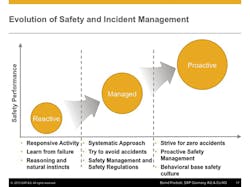When it comes to their approaches to workplace safety and health, companies today can be lumped into one of three categories: reactive, managed and proactive.
Reactive companies focus on complying with regulations and applying lessons learned from their safety failures.
Companies that take a managed approached to safety leverage systems, policies and procedures to prevent incidents. However, this group considers incidents to be a natural consequence of operations – in other words, they believe that incidents are bound to happen every now and then.
Proactive organizations have the most mature approach to EHS. Companies in this category strive for a zero-incident environment by employing proactive safety management systems and behavior-based safety strategies. These companies operate under the principle that it's not acceptable to subject employees to any kind of avoidable danger and risk, and that it's not acceptable for the operation to pose any threat to the environment.
A Systematic Approach
The third approach implies that everyone in the organization is part of the safety culture, and that all corporate functions share the same objectives for safety, health and environment. In this type of culture, EHS management isn't the exclusive domain of the safety department. Instead, it requires:
A comprehensive, integrated approach.Anyone who faces the challenge of implementing a comprehensive, proactive safety management system will need a systematic approach. This approach can be broken down into five steps: problem analysis, process design, integration design, solution setup and flexible deployment.
1. Problem Analysis
Perform a detailed and concise analysis of the current state and challenges, and of the objectives that the organization has established for operational excellence.
2. Process Design
Using the information produced by the problem analysis, develop a detailed design of the EHS management system. Such a design should focus on processes – processes that in many cases are cross-functional and interdisciplinary. This should become apparent when diagramming the work flows and information flows across the organization.
3. Integration Design
At this stage, it should become apparent where information is needed from which area – in other words, where there are integration needs between the functional areas. The comprehensiveness of a corporate safety management system inevitably creates a level of complexity with many dependencies and interdependencies – and a need for significant collaboration. Consequently, system interaction is an important factor for success.
4. EHS Solution Setup
The next step is to implement a system that facilitates safety and operational excellence. Given the many disparate stakeholder groups and their very different needs, an effective solution must be understandable, adaptable and user-friendly.
5. Flexible Deployment
Flexibility is key to the successful rollout of any new corporate program, and safety management is no exception. Organizations need to monitor the results, make changes as necessary and deploy new processes in a spirit of learning and continuous improvement.
The Bigger Picture
EHS doesn't operate in a vacuum. It is part of a complex ecosystem that includes production, maintenance, purchasing, human resources, sales, accounting and other functional areas that are intertwined and interdependent in various ways.
Compounding this complexity is the fact that most modern companies are part of a global economic system. Their customers, partners and contractors are international. They have plants and subsidiaries around the world, and they face language and cultural barriers when implementing any companywide management system.These realities point toward one critical message: An isolated approach to EHS simply won't work. In terms of the broader concept of operational excellence, EHS must be embedded into the world that we might call enterprise asset management.
No stakeholder and no activity can be considered an isolated task or responsibility. Every employee – including contract employees – and all processes must fit into an integrated and flexible system of operational excellence.
As a key component of enterprise asset management, a global EHS management system should include the following elements:
- Asset integrity – Ensuring operational performance and maintenance with a high degree of visibility.
- Operational risk management – Detecting, assessing and mitigating all relevant operational risks, i.e. risks for the individuals, for the environment and for the enterprise.
- Energy and resource efficiency – Optimizing the consumption of raw materials and natural resources with the goals of minimizing the environmental footprint, complying with environmental regulations and maximizing profits.
A comprehensive EHS management system not only must take into account the complex network of activities and responsibilities that overlap with safety but also must facilitate those functions as much as possible to improve an organization's efficiency, productivity and profitability.
Bernd Freibott is senior director and head of the SAP Global Sustainability Services Hub. Contact him at [email protected].


